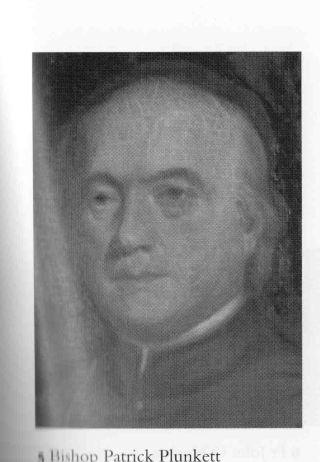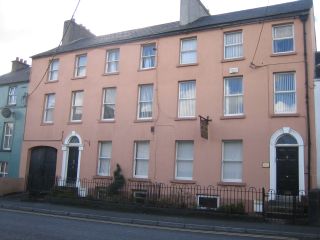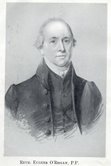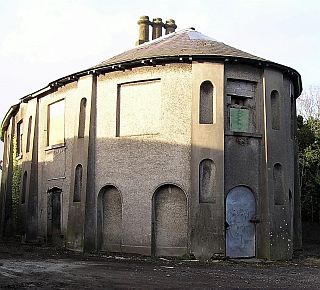St. Finian's College
Further Information: Academy Street
St. Finian’s College Navan 1802–1908
&
St. Finian’s College Mullingar 1908 to date
This article is from from History of the Diocese of Meath 1860-1993, Vol. 3

The Bishop of Meath Most Rev. Patrick Plunkett (right) in his report to Rome on the state of the diocese had the following to say about the state of education:
‘there are no Catholic seminaries in Ireland, as the penal laws, still in operation, prohibit such, and hence the youth intended for the priesthood, after acquiring the rudiments of learning at home, are obliged to travel to Catholic countries to acquire the necessary knowledge abroad.’
He reports that there was a remarkable school in Dublin, presided over by two secular priests, who had belonged to the Jesuit order before its suppression, that it had given much satisfaction and that he had adopted it as a seminary for the diocese of Meath. It was to this school that he was sending the young men intended for the priesthood for their elementary education, after which they went to the continental colleges.
Bishop Plunkett had a very keen interest in education in general. He regarded it as essential to the further well being of the faith in Ireland. Ignorance, he claimed had been the scourge of religion, whereas intelligence under proper direction would prove a valuable aid to the progress of the Church.
As a result of his interest the diocese of Meath had many schools even before the Catholic Relief Bill of 1793. His long cherishedO'Reilly, John Boyle (Writer) hope was for a Diocesan School and this hope he finally realized in 1802. Early in this year he issued a circular to his priests stating:
‘I take this opportunity to inform you that I have lately obtained a lease forever of a house and piece of ground contiguous to the town of Navan, which I destine for a diocesan academy and seminary. It will, I flatter myself, furnish the sons of affluent individuals of our persuasion with all the necessary means of a Catholic and genteel education. As a seminary, it is to unite in favour of those who aspire to our holy state, such advantages of regular discipline and select classical study as are more likely to lay the foundation of solid piety and extensive knowledge, which will hereafter, in our National College [Maynooth], form the virtuous ecclesiastic.
(below) Location of St Finian's Seminary Academy St. Navan 2011

I have purchased the above mentioned lease and made considerable progress in fitting the house, (see Academy Street) which is new, for the reception of students. £500, a present made to me by a pious individual, has already been expended on the premises. To complete the work, more still remains to be done. Unable to proceed alone, whose aid am I to invoke, if not that the Catholic parents, relations and friends of the rising generation and that of the reverend pastors of the diocese – the natural guardians of its religion and morals ? That I may not invoke their aid in vain, I may, without presumption, infer from the sentiments expressed by many of them relative to this important business.
Photo: © Navan & District Historical Society
As it is a primary object with me to connect the institution with religion and the administration of the diocese, I intend to appoint some of the principal pastors trustees to the establishment. If an expense somewhat considerable must be incurred in the beginning, I have every reason to hope that the school will, in a little time, be able to support itself, but also afford a cheap, if not a gratuitous education to such candidates as may promise, by eminently virtous dispositions and extraordinary talents, to advance the great interests of religion and do honour to their country.
My first curate under my superintendence is to be President of the Academical Seminary. He must have one or two assistants. Their salaries and maintenance are to be defrayed out of emoluments of the house. To accelerate the completion of an establishment never more urgently necessary, I request you will take the earliest opportunity of conferring on the subject with the clergy and laity of your district: you will solicit their subscriptions, receive the amounts of the sums subscribed and transmit it to me, together with the names of the subscribers, with so little delay that the immediate application of the money, the house may be made ready early in the summer.’
St Finian’s was opened on 2 May 1802
with Fr. Eugene O’Reilly (right) as its first President. 
The first student was James O’Brien of Moynalty who
later died as Parish Priest of Slane in 1849.
Fr. O’Reilly continued in office until 18th September 1805
when he was appointed Parish Priest of Dunsany.
On 31 December he resigned his post in Dunsany and
resumed at St. Finian’s. During the interval,
Fr. Christopher Bannon
[died P.P in Milltown], acted as President.
There is no complete list of students of St. Finian’s, indeed few documents connected with its early life have survived. Some information can be found in the contemporary newspapers. Here, we find a list of students who distinguished themselves:
‘ . . . at an examination held 29 December 1803 in the presence of the Right Rev. Dr. Plunkett, Dr. Sheridan and other literary gentlemen.’
Similar lists are available for several years. By 1807 it had become necessary to make provision for the growing number of students. In the Freeman’s Journal of 7 November 1807, the entry read:
“the Rev. Eugene O’Reilly begs leave to acquaint the public that he is now enlarging his house for the reception of an additional number of boarders and that there is already a vacancy for eight. When the building now going forward will be finished the Public shall have notice of its terms: twenty five guineas per annum and five guineas entrance. French have a guinea a quarter, washing ditto. Dancing and music as at the other schools. Each boarder to bring with him two pair of sheets. Payments made quarterly in advance. The quarter charged if once commenced. Separate beds.”
A notice in the same newspaper on 17th May 1808 stated that:
‘ . . . the house is now fitted up for the reception of a greater number of boarders. The addition put to it is nearly finished.’
A further notice on the 12th July announces that the addition is ‘ . . completely finished’.
In the Dublin Evening Post 26 July 1810 we read:
Roman Catholic School of Meath, Navan, conducted by the Rev. Eugene O’Reilly, under the inspection of Right Rev. Dr. Plunkett.
The Public Examinations terminated on the 19th instant. The young gentlemen who distinguished themselves, received, in presence of a numerous and respectable assembly, printed certificates, as honourable memorials of the success with which their studies were crowned.’
The following notices from the same newspaper are also of interest:- 6 August 1814 – “The house, healthful, convenient, well suited to the present purpose; has been further improving by the building of a study hall, between fifty and sixty feet long, proportionably lofty and wide, with dormitories of the same extent, so as to afford accommodation for an additional number of students and masters.’
6 January 1816 – ‘The friends of this Institution and the Public, are hereby informed that in consequence of the improvements lately made, the House is prepared for the reception of an additional number of students. 11th January 1816 – ‘The following items are extra charges, viz, Coach fare, Pocket money, Postage of letters, Medical attendance, Music, Dancing, Fencing and the clothes necessary for the students, who may at any time be called home, as on these occasions, they are never to bring the uniform dress of the school.’
A fragment of the 1821 census has survived and with it the names of the staff and students of St. Finian’s. The college then had sixty boarders ranging in age from five to twenty two, a staff of three including the president, a number of house servants and a resident tailor and shoemaker. The Catholic Directory of the same year gives the following account:
In Navan is kept the Roman Catholic Diocesan School of Meath, under the immediate inspection of the Bishop and conducted by the Rev. Eugene O’Reilly, who employs, as his assistants, persons of the first abilities in their several departments, amonst whom is the Rev. John McEncroe. This establishment has now existed near twenty years, in which time vast numbers of young gentlemen from every part of Ireland have been educated in it, some of whom have excelled in the various learned professions. The plan of education embraces the divers branches of literature which are calculated to fit young gentlemen for the College of Maynooth, Dublin. etc, Compting House, Army, Navy etc.
The classical course is generally completed within the space of five years and sometimes within a shorter period, according to the age and ability of the learner. Those who go through a course of English only, generally finish in three years.
The time for admission is from the age of seven to fourteen. Young gentlemen not having entered their twelfth year, pay forty pounds per annum. From the commencement of their twelfth year, the annual pension is increased to forty guineas. For these respective pensions they are boarded, educated and supplied with clothes, books, stationary and every other article necessary for students.
There is no vacation at any seasons of the year and the strictest attention is paid to the health, morals and general advantages of the pupils. There are generally from one hundred to one hundred and twenty students in this academy.’
The education report of 1826 states that the building cost £4,000 and that the college was attended by sixty five pupils. The boarders paid £40 per annum and the day pupils paid six guineas. The 1836 edition of Lewis’s Topographical Dictionary Vol 2, page 422 has the following description:
‘There is also an extensive Roman Catholic Seminary for students intended for the priesthood or for any of the learned professions: the school is under the direction and superintendance of three Roman Catholic clergymen; the premises are extensive and annexed to them is a private chapel.’
An advertisement appearing in the Catholic Directory of the same year makes interesting and amusing reading today. It states that:
‘the course of studies here include Logic, Metaphysics, and Ethics; the Latin, Greek, French and English languages; History – Ancient and Modern; Oratory and Declamation; pure and mixed Mathmematics; the use of globes; Geography ancient and modern with the projection of maps; Bookkeeping, Writing and the other various branches necessary for young gentlemen entering the Colleges of Maynooth, Dublin etc, the counting-house etc.
Terms:- Young gentlemen who, in addition to their board and education, are supplied with shoes, washing, boots, pens, ink, paper and every other requisite, pay each thirty guineas per annum. They are required to bring with them, on entering, two pillow cases, four night caps, two pairs of sheets and two pair of shoes. Young gentlemen who receive their board and education in the house, but who supply themselves with every other necessary article, pay each twenty four guineas per annum. The following are extra charges, viz: music, dancing, medical attendance, coach fare and postage of letters.’
St. Finian’s was, for many years after its foundation, the only seminary in the northern province and it attracted many students from all parts of Ireland. Amonst its alumni were Archbishop McGettigan, a native of Donegal and Dr. Callan the famous Maynooth College professor and scientist, a native of Armagh. An account book contains names from Dublin, Longford, Dunleer, Carrickmacross, Loughrea, Thurles, Roscommon and Ballinasloe. As late as 1866, it had students from Stradbally, Thurles and Dungarvan and even from Australia.
Fr. Eugene O’Reilly became Parish Priest of Navan in 1827 and was succeeded as president by Rev. Patrick O’Connor who had been attached to the college for several years. Fr. Cogan tells us that during his term of office he:
‘elevated the literary status of the diocesan school and was most attentive to the comfort and happiness of the students.’
Failing health required him to resign and he was succeeded by Rev. Nicholas Power, who for almost forty years was to be associated with its life. Fr. Power built the Study Hall which became the nucleus of the future St. Patrick’s Classical School, and because of its unique shape was fondly called "Power's Duck Egg" (below)

The Old St. Pat's Study Hall (Power's Duck Egg) 2006 Photo courtesy of Vincent Mulvany
A pen picture of life in St. Finian’s under his presidency, written by Fr. Laurence Grehan [died P.P. Oldcastle] can be read in Zozimus 15 March 1871 under the title of Joe Wompton’s School Days. Fr. Power gave evidence before the Endowed Schools Commission in 1854. He told the Commission that he began teaching in 1828 and had studied the educational system of France, Prussia and Austria. He encouraged the study of French in St. Finian’s and would like to introduce German. Corporal punishment was not used, he preferred to exert moral influence. He felt that expense was the main difficulty for people trying to provide education for their children and this could be alleviated by the provision of local schools above national school level. Early in 1867 Fr. Power was removed from St. Finian’s and appointed parish priest of Oristown, from which he resigned a few days later. He died parish priest of Donore.
On the removal of Fr. Power, Bishop Nulty assumed the title of President; but the actual administration of the college was carried out by Rev. Joseph Higgins, who was eventually appointed President. The course of studies followed during his presidency can be gleaned from advertisements in the catholic directories of the period. In 1876 the course of studies included:
Latin, Greek, Irish, Elementary and Higher Mathematics, Experimental Philosophy including Chemistry, Electricity & Galvanism, together with Geography, History, Use of Globes, Mensuration and other branches of Higher Education necessary to qualify students for the Civil Service Exams.’
Board and Tuition was £30 for the year. In 1879 a colonial administrator who had introduced a state educational system in Trinadad was sent to Ireland. He set up the Intermediate educational system which remained in existence until the 1990s. The state took control of the curriculum in schools by prescribing the material to be used in the three grades, Senior, Middle and Junior of the new certificate. It established a marking system and awarded scholarships on the results obtained. Schools began to establish a reputation based on these results. Beginning with the presidency of Fr. Higgins St. Finian’s became renowned for the results it achieved. From about 1879 it became customary for Meath Fourth Divinity students from Maynooth College to assist the staff of the college as Prefects of Study. This practice continued until the early 1890s.
In April 1884 Fr. Higgins was appointed parish priest of Delvin and was succeeded as president by Rev. Bernard Duff. When Fr. Duff was appointed parish priest of Taghmon two years later Fr. John Cassidy was appointed president and continued in office until 1891. Fr. Michael Dooley succeeded and when he was appointed parish priest of Killucan in 1903, Fr. Denis Flynn became president.
Towards the end of the century the need for more modern and spacious premises became apparent and Bishop Nulty acquired a site a mile outside Navan on the banks of the Boyne. He also began collecting funds for a new college building and by his death in 1898 the fund had reached £19,680. When Dr. Gaffney became Bishop he consulted the parish priests and they decided by a large majority that the new college should be built in Mullingar, the cathedral town of the diocese. Bishop Gaffney bought the present site in Mullingar for £1,127 in 1901. He visited Clonliffe College Dublin along with the Building Committee of the Vicars Forane and they decided that with some modifications it would prove a good model. Mr. Lucius O’Callaghan of Dublin was appointed architect and his plan approved. The building contract for £29,500 was secured by Gogarty of Drogheda. In addition cut stone for chimneys cost £1,900 and subcontracts for gas, heating and water brought the total contract to £36,000. The contract was signed in March 1903 and the work was completed rather later than anticipated in early 1908.
The students from Navan took up residence in the new college in February 1908 and on 2nd March it was blessed and formally opened by Bishop Gaughran. Rev. Denis Flynn who had been President in Navan was its first president.
St. Finian’s College, Mullingar [1908–1993]
Education
The programme of studies in Mullingar was the same as that followed in Navan with emphasis of the study of the Classics. The list of subjects included Religious Instruction, Latin, Greek, Mathematics, English, Irish, French, Science, History & Geography. Irish had been introduced in 1906 but was given little emphasis initially. Music was taught on a part-time basis.
From the onset St. Finian’s had a very good academic reputation, particularly nationally with regard to the Intermediate Certificate results. Scholarships were awarded nationally based on this examination, enabling students to pursue their studies to Leaving Certificate level at no cost. It was not unusual for St. Fenian’s to acquire six or more of these during the 1930s and 1940s. About twenty students were entered for the Leaving Certificate each year with the vast majority getting honours.
During the 1916 – 1922 period there was quite a fervent nationalistic spirit in the College and some students were involved in the War of Independence. Academic progress suffered, but by the early 1920s a renewed effort had been made to emulate the old standards with excellent results. The College involved itself in Leinster College’s Football and Athletics and in 1922 established an annual production of a Gilbert & Sullivan Opera.
It took part in the first Leinster Championship in 1919 and has participated ever since. The senior team scored a hat trick in the years 1925, 1926, 1927, and had a further seven wins between 1939 and 1956. In 1960 and 1966 St. Finian’s reached the All Ireland Final but was narrowly beaten on each occasion.